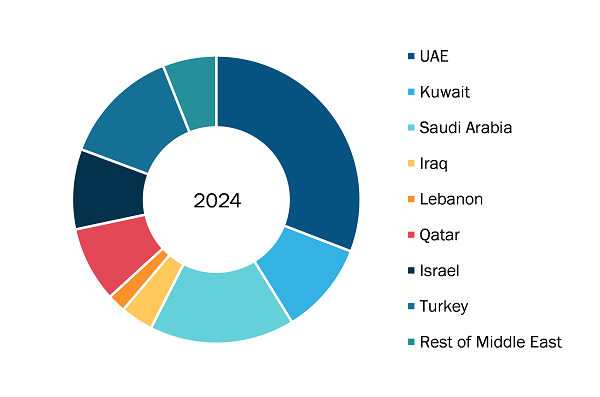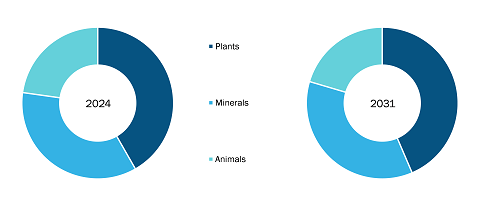Plants Segment by Source Bolsters Middle East Homeopathy Market Growth
According to our new research study on "Middle East Homeopathy Market Forecast to 2031 – Regional Analysis – by Source, Type, Application, and Distribution Channel," the market is projected to reach US$ 362.80 million by 2031 from US$ 133.11 million in 2024. The market is expected to register a CAGR of 15.5% during 2025–2031.
The report emphasizes the Middle East homeopathy market trends, along with drivers and deterrents affecting the market growth. The rising adoption of homeopathic medicine and increasing lifestyle-related and chronic diseases are contributing to the growing Middle East homeopathy market size. However, a lack of clinical evidence and insurance coverage hamper the market growth. Further, the soaring demand for plant-based supplements and launches of innovative homeopathic remedies are expected to emerge as a new market trend in the coming years.
Middle East Homeopathy Market, by Country, 2024 (%)
Middle East Homeopathy Market Size and Forecast (2021 - 2031), Regional Share, Trend, and Growth Opportunity Analysis Report Coverage: By Source (Plants, Minerals, and Animals), Type (Dilutions, Tinctures, Biochemics, Tablets, Ointments, and Others), Application (Neurology, Gastroenterology, Respiratory, Dermatology, Immunology, and Others), Distribution Channel (Homeopathic Clinics, Retail Pharmacies, e-Retailers, and Others), and Region
Middle East Homeopathy Market Growth Forecast to 2031
Download Free Sample
Source: The Insight Partners Analysis
Rise in Adoption of Homeopathic Medicine Bolsters Middle East Homeopathy Market Growth
As awareness around the side effects and limitations of conventional pharmaceutical drugs is increasing, consumers in countries, including the UAE, Saudi Arabia, and Qatar, are turning to homeopathy as a non-invasive treatment alternative.
The region's cultural and religious values support natural and integrated wellness strategies, aligning well with homeopathy’s philosophy of healing the body through natural substances and individualized treatment. The increasing incidence of chronic lifestyle-related diseases such as hypertension, diabetes, and allergies is encouraging patients to explore complementary therapies that emphasize long-term health management over symptomatic relief.
Families traditionally rely on herbal and alternative treatments passed down through generations. Health authorities and regulators in the Gulf Cooperation Council (GCC) countries are open to including alternative medicine, such as homeopathy, into national healthcare frameworks. This institutional support, combined with the proliferation of wellness centers and integrative clinics, boosts the visibility and credibility of homeopathic treatments in the region. Governments across the Middle East are undertaking initiatives to include homeopathy as a legitimate complementary medicine due to the rising awareness regarding the treatment. The UAE Ministry of Health recognizes and systematically controls the use of homeopathy. The Ministry has created exams covering medical science and homeopathy. Medical physicians and lay practitioners must pass them to practice homeopathy. In 2021, the country became one of the first in the world to incorporate homeopathy within its health insurance system. Further, homeopathy is accepted as a legitimate complementary medicine by the Iranian Ministry of Health. The reference organization for homeopathic standards is the Iranian Homoeopathic Association, which was established with the approval of the Interior Ministry and the Ministry of Health. Only physicians are permitted to practice homeopathy in Iran. These factors foster an environment conducive to expanding the homeopathy market across the region.
Middle East Homeopathy Market Report Scope:
The Middle East homeopathy market analysis has been carried out by considering the following segments: source, type, application, and distribution channel.
Based on the source, the Middle East homeopathy market is classified into plants, minerals, and animals. The plants segment held the largest share of the Middle East homeopathy market in 2024. Homeopathic products are manufactured from natural sources, such as plants, as they are believed to support the body’s innate healing capabilities. These homeopathic remedies are extracted from parts of plants, including roots, bark, leaves, and flowers. The preparation of these products involves a process known as potentization, in which extracts from plants are subjected to dilution and succession. These medicines are commonly used to address allergies, joint pain, bruises, and wounds. Arum palaestinum (Solomon’s lily) is a perennial plant native to the Levant, traditionally used in Palestine and Iraq for treating coughs, wounds, constipation, rheumatism, kidney stones, and urinary infections. Other examples include VitaMedica Arnica Montana 30X (Homeopathic tablets) and OLLOIS Dulcamara 200ck. The demand for plant-based products is rising, driven by their minimal side effects and versatile applications. The shift toward non-synthetic alternatives helps fulfill the public’s preference for plant-based products. The production of homeopathic remedies made from plants, herbs, flowers, roots, leaves, and fruits is increasing. Additionally, the growing interest in natural therapies is boosting the demand for plant-derived homeopathic products.
Middle East Homeopathy Market Size and Forecast (2021 - 2031), Regional Share, Trend, and Growth Opportunity Analysis Report Coverage: By Source (Plants, Minerals, and Animals), Type (Dilutions, Tinctures, Biochemics, Tablets, Ointments, and Others), Application (Neurology, Gastroenterology, Respiratory, Dermatology, Immunology, and Others), Distribution Channel (Homeopathic Clinics, Retail Pharmacies, e-Retailers, and Others), and Region
Middle East Homeopathy Market Growth Forecast to 2031
Download Free Sample
By type, the Middle East homeopathy market is segmented into dilutions, tinctures, biochemics, tablets, ointments, and others. The dilutions segment held the largest Middle East homeopathy market share in 2024. The fundamental concept behind homeopathy is that highly diluted substances can stimulate the body's self-healing abilities. A substance—typically a plant, mineral, or animal extract—is diluted using alcohol or water and then vigorously shaken to enhance the therapeutic potential of substances. This process, known as potentization, is believed to transfer the healing properties of the original substance into the diluted solution. In medicinal plants, homeopathic dilutions serve multiple functions, including increasing the concentration of active compounds in plants, detoxifying them, and managing diseases.
These cost-effective dilutions have minimal side effects, contributing to their popularity among patients. The increasing demand for improving medicinal efficacy while minimizing adverse effects is fueling growth in this segment, as dilution plays a crucial role in achieving these goals. Additionally, homeopathic dilutions can be used for various ailments, ranging from physical conditions such as allergies and asthma to mental illnesses such as anxiety and stress. This adaptability makes them favored for treating acute and chronic problems, thus increasing market demand. The increased awareness of the benefits of dilutions in the treatment also propels the segment’s expansion.
According to the application, the Middle East Homeopathy market is divided into neurology, gastroenterology, respiratory, dermatology, immunology, and others. The neurology regeneration segment held the largest Middle East homeopathy market share in 2024. Neurological conditions such as migraine, anxiety, and depression are rising steadily in the region, primarily due to lifestyle changes, urban stress, aging populations, and greater diagnostic capabilities. According to the World Health Organization (WHO), neurological disorders are among the leading causes of disability in low- and middle-income countries. Conventional treatments for neurological conditions often come with long-term side effects or limited efficacy. Therefore, patients are turning to homeopathy for gentle, non-invasive relief. Homeopathic remedies such as Aconite are perceived as safer alternatives to pharmaceutical drugs, especially for chronic conditions. Homeopathy practitioners recommend Aconite for intense, sudden anxiety or panic. Targeting neurological problems, homeopathic remedies with a neuroscience focus are gaining popularity and addressing the needs of patients who require long-term care.
Governments in the Gulf and Iran oversee homeopathic practices tightly, practitioners undergo certification, and in some areas (Iran), only medical doctors may prescribe these medications. This regulatory framework offers assurance to patients seeking neurology-related homeopathic care, potentially fueling demand.
Based on distribution channel, the Middle East homeopathy market is segmented into homeopathic clinics, retail pharmacies, e-retailers, and others. The homeopathic clinics segment held the largest share in the Middle East homeopathy market in 2024.
Middle East Homeopathy Market Analysis: By Region
The regional scope of the Middle East homeopathy market includes assessing the market performance in Kuwait, Iraq, Lebanon, Qatar, the UAE, Saudi Arabia, Israel, Turkey, and the Rest of the Middle East. UAE dominated the Middle East homeopathy market in 2024 and will continue its dominance during the forecast period. Homeopathy is gaining traction in the UAE, supported by major insurance providers, including it in their coverage, and pharmacies expanding their stock of homeopathic medicines. The UAE Ministry of Health (MOH) systematically recognizes and regulates homeopathy. Both medical doctors and lay practitioners can practice homeopathy. However, they should clear the MOH exams covering Medical Science and homeopathy. Homeopathy is the first treatment choice for common ailments for residents here. The report also stated that the UAE has supported the practice. The country was among the first to legalize homeopathy by introducing a licensing system for practitioners in 2003. There were ~250 licensed homeopaths in the country in 2019, of whom over 120 were in medical centers.
Patients are increasingly opting for homeopathic treatment to control chronic ailments with fewer adverse effects. This trend is evidenced by the expansion of e-pharmacies in the UAE's digital health sphere in conformity with broader CAM acceptance. The UAE employs regulatory dependence procedures and electronic submissions (eCTD), conforming to GCC practices to enhance quicker approvals of complementary medicine. Thus, the UAE homeopathy market is expanding, driven by established regulatory arrangements, quality control, global practitioner coordination, and consumer demand for safe, holistic treatment.
The National Research Council, UAE's Ministry of Health and Prevention (MOHAP), Dubai Health Authority (DHA), International Diabetes Federation (IDF), World Health Organization, and Iranian Ministry of Health are among the secondary sources referred to while preparing the Middle East homeopathy market report.
Contact Us
Phone: +1-646-491-9876
Email Id: sales@theinsightpartners.com